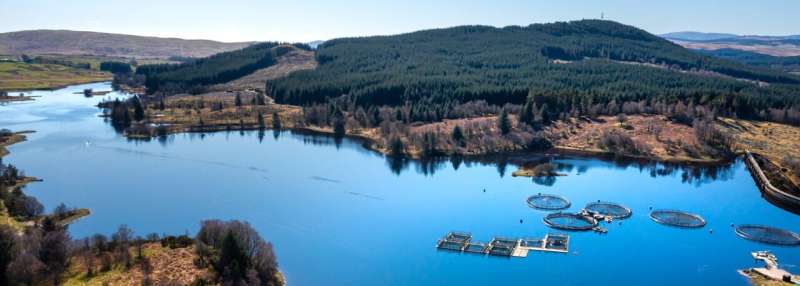This article has been reviewed according to Science X's editorial process and policies. Editors have highlighted the following attributes while ensuring the content's credibility:
fact-checked
peer-reviewed publication
trusted source
proofread
Skin cell discovery could help Atlantic salmon fend off sea lice

Scientists at the Institute of Aquaculture are central to a study that could hold the key to improving Atlantic salmon's resistance to sea lice. The parasites—which feed on the fish's skin and fins, causing open wounds that can lead to infection—reduce the market value of farmed fish and can have knock-on impacts on wild salmon populations.
Various treatments have been developed to tackle sea lice infestations in Atlantic salmon aquaculture—which costs the industry more than £700m a year—but these are often costly and ineffective. They can also be damaging to the environment and negatively affect animal welfare.
The new study reveals insights into how coho salmon—a cousin of Atlantic salmon—fight off the parasites, and it could pave the way for new genetic approaches. The findings are published in the journal BMC Biology.
Findings show a type of skin cell—known as keratinocyte—plays a key role in triggering localized swelling that helps coho salmon kill and remove sea lice.
An international team of researchers included three scientists at the University of Stirling's Institute of Aquaculture in the Faculty of Natural Sciences—Dr. Rose Ruiz-Daniels, Dr. Sean Monaghan and Professor James Bron.
Dr. Ruiz-Daniels, co-first author of the study carried out during her post doc at the Roslin Institute, said, "Sea lice is a major issue for farmed salmon. In this study we used new techniques to sequence cells of different salmonid species to discover how some can expel sea lice, forging fresh pathways for biotechnological solutions to tackle sea lice in Atlantic salmon."
Sea lice resistance
While Atlantic salmon are highly susceptible to sea lice, coho salmon have an innate resistance to them. In coho salmon, the attachment of sea lice triggers localized swelling. However, there is minimal swelling in Atlantic salmon, and the outermost layer of their skin rapidly breaks down.
Until now, the cell-level mechanisms underlying the differences in resistance between the species—which split from a common ancestor around thirty million years ago—have remained unknown.
The team which made the discovery was led by scientists at the Roslin Institute and Norwegian food science research institute Nofima (The Norwegian Institute of Food, Fisheries and Aquaculture Research). They analyzed the molecular and cellular mechanisms that underlie coho salmon's sea lice resistance and compared this to the response in Atlantic salmon.
Genetic shield
After exposing both species to the parasites, researchers investigated the cell types and gene expression patterns of their responses by analyzing skin samples using a novel type of RNA sequencing that allows the characterization of gene expression of individual cells.
They found that, while both species mount similar immune and wound-healing responses, keratinocytes in the three outermost layers of coho salmon's skin play a central role in their response to infection.
Their findings suggest that keratinocytes in the bottom layer direct the expansion and movement of cells in the middle and top layers, which can eventually encapsulate and expel the parasites. Findings also revealed that sea lice can weaken the immune system of Atlantic salmon.
Using gene editing, it could be possible to enhance Atlantic salmon's sea lice resistance.
Dr. Sarah Salisbury, Postdoctoral Research Fellow at the Roslin Institute, said, "We were able to pinpoint with unprecedented resolution the types of cells responsible for the skin swelling response used by coho salmon to resist sea lice, as well as those cells targeted by sea lice in Atlantic salmon to weaken this host species. These insights pave the way for the development of transformative therapies to counter this devastating parasite."
More information: S. J. Salisbury et al, Keratinocytes drive the epithelial hyperplasia key to sea lice resistance in coho salmon, BMC Biology (2024). DOI: 10.1186/s12915-024-01952-8
Journal information: BMC Biology
Provided by University of Stirling





















